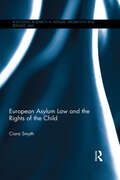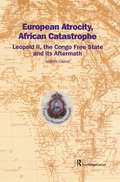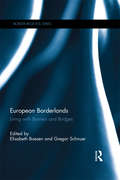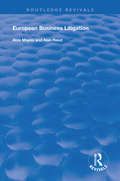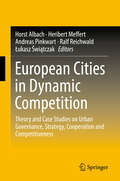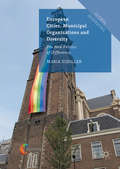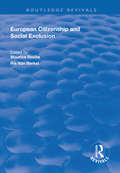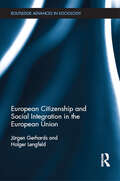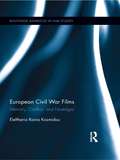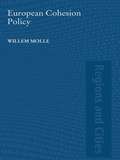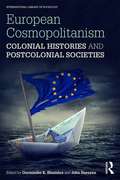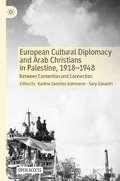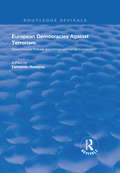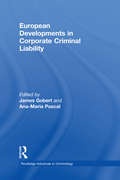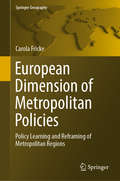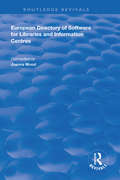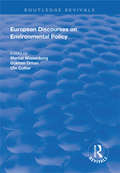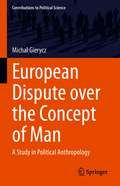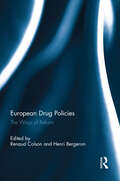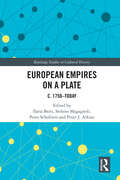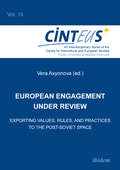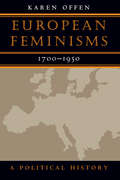- Table View
- List View
European Art Cinema (Routledge Film Guidebooks)
by John WhiteEuropean art cinema includes some of the most famous films in cinema history. It is elite filmmaking that stands in direct opposition to popular cinema; and yet, it also has an intimate relationship with Hollywood. This guidebook sketches successive phases of art cinema in Europe from its early beginnings of putting Shakespeare’s plays on the screen, through movements such as Expressionism and Surrealism, to the New Waves of the 1960s and more recent incarnations like Dogme 95. Using film examples, John White examines basic critical approaches to art cinema such as semiotics and auteur theory, as well as addressing recurring themes and ideas such as existentialism and Christian belief. The different levels of political commitment and social criticism, which appear in many of these films, are also discussed. The book includes case studies of eight representative films: • The Cabinet of Dr Caligari (Wiene, 1920) • Earth (Dovzhenko, 1930) • A Man Escaped (Bresson, 1956) • Hiroshima mon amour (Resnais, 1959) • Aguirre, Wrath of God (Herzog, 1972) • Comrades (Douglas, 1986) • Le Quattro Volte (Frammartino, 2010) • Silence (Collins, 2012).
European Asylum Law and the Rights of the Child: European Asylum Law And The Rights Of The Child (Routledge Research in Asylum, Migration and Refugee Law)
by Ciara SmythThe child asylum seeker poses unique challenges for reception and refugee status determination systems, not least because the child is entitled to have his or her rights as a child respected as a matter of international and regional human rights law. In the last decade the European Union has increasingly engaged with children’s rights, with the entry into force of the Lisbon Treaty in December 2009, and a new Article 3(3) of the Treaty on European Union that commits the Union to promoting the ‘protection of the rights of the child.’ This book addresses the question of whether the Common European Asylum System (CEAS) complies with the rights of the child. It contrasts the normative standards of international child rights law with the treatment of child asylum seekers and refugees in the CEAS. Ciara Smyth identifies the attributes of the rights of the child that are most relevant to the asylum context and systematically examines whether and to what extent those attributes are reflected in the CEAS legislation. The book goes on to assess whether the CEAS instruments direct Member States to comply with the rights of the child, offering a comprehensive examination of the place of the child within European asylum law and policy. The book will be of great use and interest to scholars and students of international law, immigration and children’s rights studies.
European Atrocity, African Catastrophe: Leopold II, the Congo Free State and its Aftermath
by Martin Ewans Sir Martin EwansThere is a broad consensus among those who are concerned with Africa that the plight of the continent is approaching the catastrophic. Partly the roots of the problem are historical, stemming from the exploitation and colonisation of the continent by European powers. An appreciation of the history of the relationship between Europe and Africa, a major episode of which this book examines, is indispensable to an understanding of the continent's present predicament. In the late 19th and early 20th centuries King Leopold II of the Belgians established a colony in Africa, which, as the Congo Free State, became a byword for unremitting exploitation and widespread atrocities. This book describes the creation, the development and the collapse both of this regime and of the Belgian colony that replaced it. Conclusions are drawn about the nature of European colonialism in Africa and the consequences for Europe itself.
European Borderlands: Living with Barriers and Bridges (Border Regions Series)
by Edited by Elisabeth Boesen and Gregor schnuerThe expectations of European planners for the gradual disappearance of national borders, and the corresponding prognoses of social scientists, have turned out to be over-optimistic. Borders have not disappeared – not even in a unified and predominantly peaceful Europe – but rather they have changed, become more varied and, in a certain sense, mobile, taking on an important role in the everyday lives of more people than ever before. Furthermore, it is now widely accepted that borders do not just hinder communication and the formation of relationships, but also channel and prefigure them in a positive way. Presenting a number of studies of everyday life in European borderlands, this book addresses the multifarious and complex ways in which borders function as both barriers and bridges. Focusing on ‘established’ Western European borderlands – with the exception of three contrasting cases – the book attempts a turn from conflict to harmony in the study of borderlands and thus examines the more mundane manifestations of border life and the complex, often unconscious motives of everyday cross-border practices. The collection of chapters demonstrates that even in the case of ‘open’ political borders, the border remains an enduring factor that is not adequately described as either a problematic barrier or a desirable bridge. The studies look at bordering processes, not only approaching them from different disciplinary angles – sociology, anthropology, geography, history, political science and literary studies – but also choosing different scales and making comparisons that range from different borders of one country to the reactions and attitudes of different individuals in a single borderland village.
European Business Litigation (Routledge Revivals)
by Alan Reed Abla MayssFirst published in 1998, European Business Litigation is a monograph produced as a follow-up step to European Business Law which contains a range of chapters, including a chapter on Business Litigation. Hence, as well as expanding on the issues raised in the chapter, this book provides an insight into the legal and policy problems involved in both the harmonisation process and the substantive EU laws adopted to ameliorate the situation in the field of Private International Law. More specifically, it examines the origin of EU laws in this area, considers the problems with their interpretation and implementation, and addresses the question of whether harmonisation has been achieved.
European Cinemas, European Societies: 1939-1990 (Studies In Film, Television And The Media Ser.)
by Pierre SorlinFirst published in 2004. Routledge is an imprint of Taylor & Francis, an informa company.
European Cities in Dynamic Competition: Theory and Case Studies on Urban Governance, Strategy, Cooperation and Competitiveness
by Horst Albach Heribert Meffert Andreas Pinkwart Ralf Reichwald Łukasz ŚwiątczakWorld population and the number of city dwellers are steadily growing. Globalization and digitalization lead to an increased competition for skilled and creative labor and other economic resources. This is true not only for firms, but increasingly also for cities. The book elaborates on resulting challenges and opportunities for urban management from the European perspective, and discusses theories, methods and tools from business economics to cope with them. Contributions in this volume come from scholars and practitioners of economics, business administration and urban management, and cover aspects ranging from urban dynamics to city marketing. They draw on experiences from several European cities and regions, and discuss strategies to improve city performance including Open Government, Smart City, cooperation and innovation. The book project was initiated and carried out by the Center for Advanced Studies in Management (CASiM), the interdisciplinary research center of HHL Leipzig Graduate School of Management. It is addressed to scholars and managers in Europe and beyond, who will benefit from the scientific rigor and useful practical insights of the book.
European Cities, Municipal Organizations and Diversity
by Maria SchillerThis book challengesthe prevailing view that local authorities are irrelevant in immigrationpolicy-making. Presenting an in-depth ethnographic study of the recentimplementation of local 'diversity policies' in the Netherlands, Belgium andUnited Kingdom, it identifies a new politics of difference, characterized by a'paradigmatic pragmatism'. Building on extensive fieldwork in Amsterdam,Antwerp and Leeds, the author shows that, rather than simply replacing anearlier politics of difference, local diversity policies combine ideals ofmulticulturalism, assimilation and diversity. She links these findings to theongoing modernization and diversification of municipal authorities, and theimpact of this transformation on the profile of the bureaucrats and theirimplementation of diversity policies. This thought-provoking work will appealto students, researchers and practitioners engaged in the fields ofimmigration, diversity and multiculturalism.
European Citizenship and Social Exclusion (Routledge Revivals)
by Maurice Roche Rik Van BerkelFrist published in 1997, this book aims to answer if European ‘post-national’ citizenship provide a practical opening and a conceptual challenge to cope with the diverse and close-circuiting crises of national European social models? What then might a new sphere of European social inclusion look like? This book also provided the first attempt to go well beyond ‘national gridlock’. Old solutions will no longer do. Is new land in sight? With monetary integration almost implemented this is a highly relevant exploration of a central complementary ‘common currency’ in Europe’s future.
European Citizenship and Social Integration in the European Union (Routledge Advances in Sociology)
by Jürgen Gerhards Holger LengfeldSince 2008, the European Union has been affected by one of the most severe crises in the history of Europe. This book builds on the work of Jürgen Habermas to answer the key question: is Europe strong enough to overcome the recent crisis? Arguing that recovery can only take place if the citizens of Europe regard themselves as members of a socially integrated European society, this volume sets out three conditions for successful European social integration: <P><P> European citizens mutually respect each other as equals, accepting that all EU citizens should have equal economic, political and social rights. Those citizens objecting to the idea of European equality should not constitute a minority with potential for mobilisation that could impede the ongoing process of European social integration. Europeans act upon their equality beliefs in everyday practice – without differentiating between nationals and EU migrants. <P><P> Based on a survey carried out in Germany, Spain, Poland and Turkey, the authors argue that the requirements for a socially integrated Europe are largely in place already. Their findings allow for optimism regarding the future of the EU, as the cultural foundations for a democratisation of Europe are laid. This volume develops a theoretical framework of a socially integrated European community, and will be useful for students and scholars of sociology, citizenship studies, social policy, political science and European studies.
European Civil War Films: Memory, Conflict, and Nostalgia (Routledge Advances in Film Studies)
by Eleftheria Rania KosmidouThis book examines the ways in which late twentieth-century European cinema deals with the neglected subject of civil war. Exploring a range of films about the Spanish, Irish, former Yugoslavia, and Greek civil wars, this comparative and interdisciplinary study engages with contemporary debates in cultural memory and investigates the ways in which cinematic postmemory is problematic. Many of the films present an idealized past that glosses over the reality of these civil wars, at times producing a nostalgic discourse of loss and longing. Other films engage with the past in a melancholic fashion. These cinematic discourses articulate contemporary concerns, especially the loss of ideology and a utopian political horizon in the aftermath of the collapse of the Soviet bloc in 1989, a date that marks a significant break in European history and an accompanying paradigm shift in European cultural memory. Filmmakers examined include Trueba, Cuerda, Loach, Jordan, Kusturica, Dragojević, and Angelopoulos.
European Cohesion Policy: The Theory And Practice Of European Policy Making (Regions and Cities)
by Willem MolleThe only comprehensive text available for advanced study and professional reference, this book brings much needed clarity to both the theoretical and practical aspects of EU intervention. Integrating both theoretical and practical research in a clear and accessible structure, covering economic, social and territorial issues European Cohesion Policy provides a systematic view of the various stages of the whole policy cycle, looking in detail at: the evolution of the problems the design of the policy system the implementation in practice the evaluation of effects . An authoritative analysis of the problems and debates involved, European Cohesion Policy is essential reading for students, policy makers, development workers and researchers working in all aspects of European policy.
European Cosmopolitanism: Colonial Histories and Postcolonial Societies (International Library of Sociology)
by Gurminder K. Bhambra John NarayanThis book provides a fresh examination of the cosmopolitan project of post-war Europe from a variety of perspectives. It explores the ways in which European cosmopolitanism can be theorized differently if we take into account histories which have rarely been at the forefront of such understandings. It also uses neglected historical resources to draw out new and unexpected entanglements and connections between understandings of European cosmopolitanism both in Europe and elsewhere. The final part of the book places European cosmopolitanism in tension with contemporary postcolonial configurations around diaspora, migration, and austerity. Overall, it seeks to draw attention to the ways in which Europe’s posited others have always been very much a part of Europe’s colonial histories and its postcolonial present.
European Cultural Diplomacy and Arab Christians in Palestine, 1918–1948: Between Contention and Connection
by Karène Sanchez Summerer Sary ZananiriThis open access book investigates the transnationally connected history of Arab Christian communities in Palestine during the British Mandate (1918-1948) through the lens of the birth of cultural diplomacy. Relying predominantly on unpublished sources, it examines the relationship between European cultural agendas and local identity formation processes and discusses the social and religious transformations of Arab Christian communities in Palestine via cultural lenses from an entangled perspective. The 17 chapters reflect diverse research interests, from case studies of individual archives to chapters that question the concept of cultural diplomacy more generally. They illustrate the diversity of scholarship that enables a broad-based view of how cultural diplomacy functioned during the interwar period, but also the ways in which its meanings have changed. The book considers British Mandate Palestine as an internationalized node within a transnational framework to understand how the complexity of cultural interactions and agencies engaged to produce new modes of modernity.
European Democracies Against Terrorism: Governmental Policies and Intergovernmental (Routledge Revivals)
by Fernando ReinaresThis title was first published in 2000. In this multidisciplinary volume, contributors critically assess the different measures designed and implemented by western European democratic governments since the late 1960s in order to counter the challenge of terrorism. The work also analyzes the problems and perspectives surrounding intergovernmental co-operation against such evolving phenomenon, as developed within the framework of the European Union.
European Developments in Corporate Criminal Liability (Routledge Advances in Criminology)
by James Gobert Ana-Maria PascalWhen corporations carry on their business in a grossly negligent manner, or take a cavalier approach to risk management, the consequences can be catastrophic. The harm may be financial, as occurred when such well-regarded companies as Enron, Lehman Brothers, Worldcom and Barings collapsed, or it may be environmental, as illustrated most recently by the Gulf oil spill. Sometimes deaths and serious injuries on a mass scale occur, as in the Bhopal gas disaster, the Chernobyl nuclear explosion, the Paris crash of the Concorde, the capsize of the Herald of Free Enterprise, and rail crashes at Southall, Paddington and Hatfield in England.What role can the law play in preventing such debacles and in punishing the corporate offenders? This collection of thematic papers and European country reports addresses these questions at both a theoretical and empirical level. The thematic papers analyse corporate criminal liability from a range of academic disciplines, including law, sociology/criminology, economics, philosophy and environmental studies, whilst the country reports look at the laws of corporate crime throughout Europe, highlighting both common features and irreconcilable differences between the various jurisdictions.
European Dimension of Metropolitan Policies: Policy Learning and Reframing of Metropolitan Regions (Springer Geography)
by Carola FrickeThis book questions how policies for the metropolis become Europeanised. The book analyses how spatial concepts and political ideas permeate the European multi-level system. Through an interpretive comparison of five contexts, the book provides an overview of the European orientation tracing two interdependent developments. First, the book examines references to ‘Europe’ in national and subnational policies. In French and German policies, metropolitan regions are increasingly framed as being central not only for inter-municipal coordination, but also as nodes within the European space. Moreover, Europeanised metropolitan regions such as Lyon and Stuttgart develop European strategies. The second development shows how metropolitan regions appear as actors and issues in the European policy arena, contributing to a tentative and implicit metropolitan dimension. This multi-scalar analysis is of interest for scholars and practitioners specialised in metropolitan regions, European urban and regional policies, geography and related areas.
European Directory of Software for Libraries and Information Centres (Routledge Revivals)
by Joanna WoodFirst Published in 1993 A Directory of Library and Information Software for Microcomputers has been published in four highly successful editions. The growth of interest in and proliferation of software packages in Europe has caused this new edition of the Dictionary to concentrate on the software that is both actively marketed in Europe and that has good back up support. The coverage is restricted to microcomputer software that is running under MS DOS/PC DOS, OS/2, UNIX, PICK and APPLE MACINTOSH operating systems. All software suitable for use in library and information work will be included, but not industry-standard word processing spreadsheets, accounts or other office administration systems. Coverage of Europe includes the 12 EC countries together in Sweden, Norway, Finland, Switzerland and Austria. More than 278 packages are listed originating from 299 suppliers. The European Directory is arranged in a straight alphabetical sequence by software name, indexed by country, by operating system and by supplier.
European Discourses on Environmental Policy (Routledge Revivals)
by Marcel Wissenburg Gökhan Orhan Ute CollierFirst published in 1999, this volume contributed to the debate on the European Union in furthering the study of environmental policy and, expressly, by introducing promising young scholars to the debate. The volume is based on a series of seminars for the Interdisciplinary Research Network on Environment and Safety (IRNES) with funding from the UK Economic and Social Research Council (ESRC). These new scholars explore areas including post-decisional politics, sustainability and agricultural biotechnology regulation.
European Dispute over the Concept of Man: A Study in Political Anthropology (Contributions to Political Science)
by Michał GieryczThe book represents original research in a field of study rarely pursued while analysing the intellectual dimensions of disputes over ethically sensitive issues that occur in European Union politics. These disputes are generally analysed at ideological, ethical, economic and interstate levels. However, these references do not suffice in understanding the issue, which is related to a divergent perception of the essence of humanity and thus the subject matter of anthropology. The main research objective of the monograph is therefore to reconstruct the sources and the specific European Union way of thinking about the human being. Methodologically, the book expands the understanding of political anthropology within political science and presents a range of suitable instruments for pursuing anthropological research. At the theoretical level, it proposes an anthropological typology of the main currents of European political thought and reveals their prominence for the anthropological orientation of the EU's axiology. Empirically, it provides an analysis of the anthropological features of European Union institutions and policies in addition to discussing the relation between the axiological and anthropological positions of the main political and national groups within the EU.
European Drug Policies: The Ways of Reform
by Renaud Colson Henri BergeronThe drug control regime established by the international community has not succeeded in curbing either the demand for, or the offer of, narcotics. But, despite a series of developments in the Americas – including the legalisation of cannabis in Uruguay and in several states in the United States of America – there is still little support in Europe for repealing drug-prohibition laws. Nevertheless, a gradual policy convergence reveals the emergence of a European model favouring public-health strategies over a strictly penal approach to combatting drugs, while growing transnational support for legalisation indicates the persistence of an alternative paradigm for drug policy. This book examines the various influences on drug policies in Europe, as grassroots movements, NGO networks, private foundations and academic research centres increasingly confront the prevailing discourses of drug prohibition. Pursuing an interdisciplinary approach and bringing together legal scholars, social scientists and practitioners, it provides a comprehensive and critical assessment of drug policy reform in Europe.
European Empires on a Plate: c. 1750–Today (Routledge Studies in Cultural History)
by Peter Scholliers Peter J. Atkins Ilaria Berti Stefano MagagnoliThis book uses food to explore the uneven and multifaceted encounters between European imperial societies and their colonies, examining the cultural, social, political and economic forces behind European empires.Food is a key focus of current transdisciplinary and border research, and these chapters uncover hidden aspects of imperial dynamics and the search for food in European expansion. Containing contributions from a mix of established food historians and young researchers in the field, the collection utilizes a range of sources including colonial government records, trademark and patent records, cookery books, agronomic and botanical treaties, television shows, newspaper and magazine articles and advertisements. While the book discusses empires’ influence on the colonies and their foodways, it also reveals inter-imperial connections and interdependence by highlighting the effect of colonial foods on the metropoles.European Empires on a Plate is a valuable resource for scholars in the fields of food history, food studies and food culture, as well as social and cultural historians.
European Encounters: Migrants, Migration and European Societies Since 1945 (Research in Migration and Ethnic Relations Series)
by Karen Schönwälder Rainer OhligerThis book reminds us of Europe's multi-faceted history of expulsions, flight, and labour migration and the extent to which European history since 1945 is a history of migration. While immigration and ethnic plurality have often been divisive issues, encounters between Europeans and newcomers have also played an important part in the development of a European identity. The authors analyze questions of individual and collective identities, political responses to migration, and the way in which migrants and migratory movements have been represented, both by migrants themselves and their respective host societies. The book's distinctive multi-disciplinary and international approach brings together experts from several fields including history, sociology, anthropology and political science. ’European Encounters’ will serve as an invaluable tool for students of contemporary European history, migration, and ethnic identities.
European Engagement Under Review: Exporting Values, Rules, and Practices to the Post-Soviet Space (An Interdisciplinary Series of the Centre for Intercultural and European Studies #15)
by Vera AxyonovaThis timely book seeks to contribute to the debate on the transfer of values, rules, and practices by European actors to former Soviet countries. The actors in focus include multilateral organizations, such as the European Union, the Council of Europe, and the Organization for Security and Cooperation in Europe, as well as European governments and non-governmental organizations. The contributions in this collection address different aspects of the export or transfer of values, such as democracy, human rights, and the rule of law, as well as rules and practices in the fields of education and migration management, examining the motives, mechanisms, and effects of European engagement.
European Feminisms, 1700-1950: A Political History
by Karen OffenThis ambitious book explores challenges to male hegemony throughout continental Europe. It focuses especially on France, but it also offers comparative material on developments in the German-speaking countries and in the smaller European nations and aspiring nation-states. Spanning 250 years, the sweeping coverage extends from Portugal to Poland, Greece to Finland, Ireland to Ukraine, and Spain to Scandinavia--as well as international and transnational feminist organizations. The study has several objectives. For general readers and those interested primarily in the historical record, it provides a comprehensive, comparative account of feminist developments in European societies, as well as a rereading of European history from a feminist perspective. By placing gender, or relations between women and men, at the center of European politics, where the author argues that it belongs but from which it has long been marginalized, the book aims to reconfigure our understanding of the European past and to make visible a long but neglected tradition of feminist thought and politics. On another level, by providing a broad and accurate historical analysis, the book seeks to disentangle some misperceptions and to demystify some confusing contemporary debates about the Enlightenment, reason, nature, equality vs. difference, and public vs. private, among others. The author argues that historical feminisms offer us far more than logical paradoxes and contradictions; feminisms are about sexual politics, not philosophy. Feminist victories are not, strictly speaking, about getting the argument right, nor is gender merely "a useful category of analysis"; sexual difference lies at the heart of human thought and politics.

